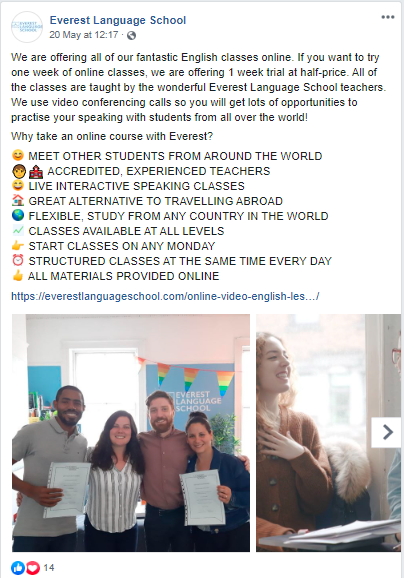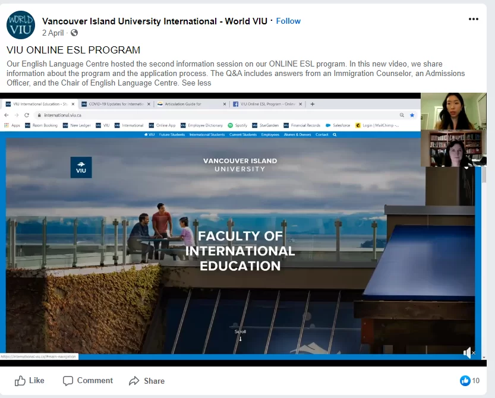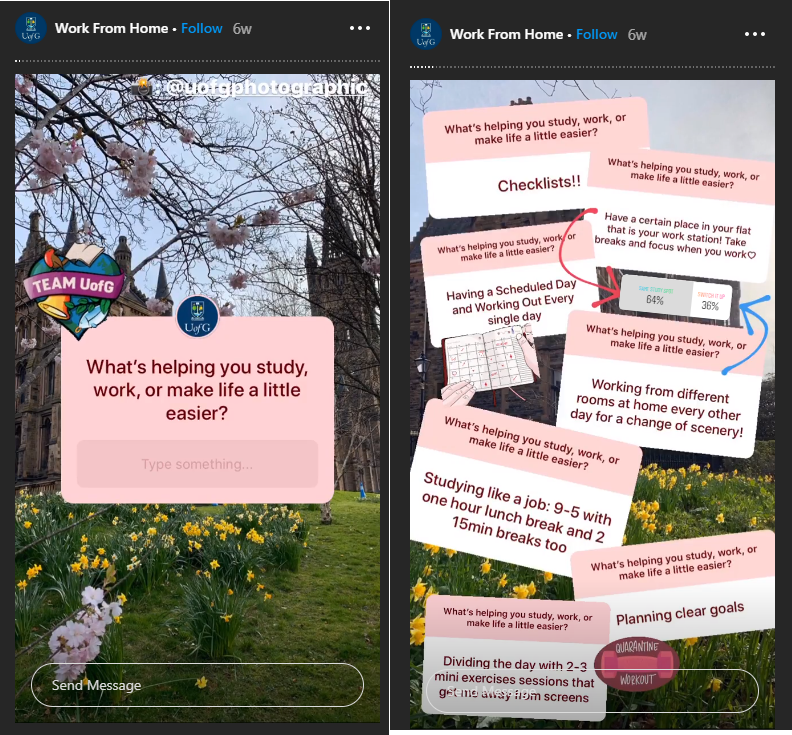Social media is often where many institutions showcase the lighter side of school life. From stories and posts highlighting student social events to photos and videos that capture the beauty and bustle of a campus in full swing, the channel’s visual, casual, and communal nature makes it one of the most engaging marketing tools available. Intrigued? Read on to learn how to promote courses on social media.
Changes in our lifestyles have led to a significant rise in social media, giving schools countless opportunities to connect, engage, and attract new prospects.
Research shows that global social CPM grew 41% year-on-year in Q2 2021. In this new landscape, campaigns designed to boost brand awareness or traffic have increased by 114%, driven by a 62% increase in CPM.
This sets the stage nicely for schools looking to spread awareness about their online programs, but it also introduces a range of questions that may be difficult to navigate for those just starting. For instance, how do you find Instagram-friendly visuals when your campus is empty? How do you create a sense of community among your students when they are studying from home? And how do you highlight everything your course promotion in a way that will speak to a social media audience?
Fortunately, there are plenty of inventive ways to showcase learning on social networks and even use the change in medium to your advantage.
1. Before You Begin, Define the Personas & USPs of Your Courses
Understanding how student personas may differ for online courses compared to traditional classroom settings is crucial, so many schools have to rethink their student personas. Consider factors like the potential for attracting students from a broader geographic range, the flexibility that might appeal to working professionals, and the age demographics that may shift as more individuals seek to enhance their skills or change careers.
This exercise can drive your school’s approach across several digital channels, and social media is no exception.
Your team should consider how different the potential audience for their online courses will be compared to their classroom prospects. Such questions to consider are:
- Will the accessibility of online learning lead to you attracting prospects from further afield?
- Will the flexibility of the format mean that more students study while working?
- Will they be older now that the economic impact of the pandemic has led to people rethinking their career paths?
Example: Online course provider FutureLearn understands the needs and wants of its audience, and the content it shares on social media very much reflects that.

Asking these questions and creating a picture of your ideal online applicant will also help clearly define your courses’ unique value proposition.
For instance, many language schools have traditionally relied heavily on the attractiveness of their location as a study destination, emphasizing opportunities for sightseeing, social life, and language immersion. However, this benefit has been negated for online programs, and these institutions have needed to emphasize the strength of their course content, instructors, and online learning facilities.
Example: This Facebook post from Everest Language School lays out the value of their new online courses quite well.

Source: Everest Language School
Once you have a clearly defined persona and key messages, you can tailor your social media strategy and discover how to promote courses to students more effectively. You will probably even find ideas for posts, tactics, and priority channels become much clearer right away.
2. Choose Your Social Networks When Exploring How to Promote Courses on Social Media
It’s important to consider which social networks you focus on to promote your courses. As obvious as this may seem, it’s worth reiterating because you may find that the social channels you use to promote your classroom-based courses don’t generate the same engagement or reach the right audience for online learning.
For instance, you might have a robust Instagram presence, but the highly visual nature of the site could make it less than ideal for showcasing your online courses. The fact that you cannot place links in posts could also limit the number of leads you generate, which might be particularly limiting given that many schools need to drum up interest in new online courses quickly.
Recent data suggests that Instagram has declined engagement during the pandemic as its audience switches attention to more news-focused social media. However, the platform is still one of the most popular social networks:

Source: Statista
Another platform in the running is TikTok. According to 2024 research, 69% of brands utilize TikTok, so it would help to carefully analyze your current social calendar and what attention you give to specific sites, and you shouldn’t be afraid to shake things up.
3. Optimize Your School’s Social Media Profiles
For schools marketing education for the first time, half the battle will be informing their current audience about available options. One thing you should consider to help get the message across is optimizing their social media profiles to make their learning options more prominent.
An example of optimizing your social media profile can include updating the About section on your Facebook page to include information about the courses you provide in your Company Overview, Products, and Milestones sections.
Example: IE Business School includes recent awards and recognition it has received for its online MBA program in its Milestones section. In the current climate, this information will inspire confidence in prospects.

Source: IE Business School
You could also update the main link in your Instagram profile to direct prospects to your course options if you’re considering how to promote courses on social media. Alternatively, you could change your Facebook cover image during this period to help draw prospects’ attention.
Example: Speak Up London Language School now has a video on its Facebook cover promoting online ESL classes.

Source: Speak Up London Language School
These small details will help raise awareness and reposition your school as a reputable learning provider on social media. Interested in working with us to develop your social media strategy? Contact our team for custom-tailored insights.
4. Video is Your Friend When Promoting Courses
Because online classes are based mainly on video platforms, the material you develop for your courses can be easily promoted. You can use inexpensive video editing software to create eye-catching clips that offer a glimpse of your learning management system (LMS), showcase the value of your online courses, and drive prospects toward inquiries. You can also use this technique to promote your traditional courses, appealing to your audience on social media through engaging content.
According to HubSpot, short-form videos are expected to grow the most in 2024.
Example: In this recent YouTube video, International House London combined footage of its remote students and LMS to create a vibrant and engaging promotion for its new online ESL courses.

One of the major benefits of creating video content is that it tends to attract a lot of engagement and reach, which could help you gain traction and leads for your online courses much faster from social media.
5. Facebook Live: A Solution for Schools Seeking How to Promote Courses on Social Media
In addition to posting videos on social media, you can go one step further and broadcast live when exploring how to promote a course on social media. Live Streaming has been one of the biggest social media success stories of the past few years, particularly on Facebook. Since its launch in 2016, Facebook Live has attracted over 3 billion viewers.
Moreover, the Facebook Live format perfectly showcases your school’s learning experience. Your school could host live Q&A sessions, tutorials for your LMS, or even free introductory classes through the platform.
Example: Vancouver Island University hosted this online information session last month about its online ESL program

Source: Vancouver Island University International
Livestreaming will give your prospects a firsthand taste of the environment you create for students. For schools offering online programs, live streaming can even showcase the interactivity and communication the format can facilitate.
6. Share Resources From Your Courses
In addition to using video to offer a sneak peek of your classes, you could also share some of the other components of your courses on social media. Schools searching for course advertisement ways on social media can use course assets to boost engagement creatively. For instance, course quizzes, reading material, or other learning resources can be repurposed and posted on your social media accounts.
Many schools are taking this even further and offering free trials of their classes to prospects, which could be particularly beneficial if you are new to the format.
Example: IH Bristol offers free trials of its online language courses to followers on Facebook.

Source: International House Bristol
Offering content with this level of value will show prospects that your courses are robust and rich in learning support, as well as give them the chance to sample aspects of your classes to get a feel for what it is like studying with you.
7. Create Stories as You Consider How to Promote Courses on Social Media
Given their very visual nature, stories might not seem like a natural fit if you’re searching for how to promote courses on social media. However, the format’s versatility could give you plenty of scope to showcase your school’s learning experience. For instance, you could use some of your learning materials to create quizzes or polls to test prospects’ knowledge and give them a preview of what to expect.
Social media stories’ interactivity can also be a great way to build community and engagement remotely. For instance, in the aftermath of COVID-19, several schools have utilized the format to offer practical tips for studying remotely. This could help assuage students’ concerns about learning online or with your school in general.
Example: The University of Glasgow created a story that asked students to share their best tips for studying from home and then shared some answers.

Source: University of Glasgow
8. Don’t Forget the ‘Social’ Aspect of Learning on Social Media
Offering opportunities for socializing while promoting your courses can help you create ways for your community to connect better. Schools forced to close campuses due to the pandemic have also been mindful of this aspect of the student experience, and many have worked to create virtual events and activities to fill the void.
Social media can be the perfect place to promote this aspect of your school, showcasing a vibrant student life experience. You can create posts, stories, and videos to raise awareness of your events and show prospects what they are missing.
Example: Socializing has always been a big part of the language education experience. Now, in the absence of on-campus activities, many schools run virtual social programs for online students. IH Manchester, for instance, runs concerts, quizzes, and other events online and promotes them on its Instagram account.

Source: IH Manchester
‘Social proof’ can also be incredibly valuable for schools wondering how to promote courses on social media, particularly in the early stages of their ventures into online learning. Sharing testimonials from students who have had positive experiences studying with your school will reassure prospects that your courses represent good value.
Example: ILSC Toronto shared a video testimonial from an online student. In it, she praises the course and opportunities for socializing online with fellow students, making it an incredibly valuable promotional asset.

Source: ILSC Toronto
9. Use Social Media Ads to Make a Name for Your Courses
When considering how to recruit students through social media, it’s important to remember that your organic reach on most popular networks is likely to be quite limited these days.
With that in mind, investing in paid social media ads could be prudent, especially if your student personas have changed significantly with the move to online learning. Advertising could help you get your courses seen by the audience you are now targeting and generate leads quickly.
Example: EF English Live runs Facebook Ads to reach prospective online students in the Taiwanese market.

Source: EF English Live
10. Post, Post, and Post Some More About Your Courses
As much as these tactics will help you make your courses stand out, the best thing you can do when marketing your school’s courses is post, post, and post some more. When trying to get the word out about a course, mentioning it frequently on your social accounts is the most surefire way to create awareness.
Example: Inlingua Malta made posting about its online courses a top priority on Facebook.

This is especially true if you are new to the online learning arena. In this situation, your followers and prospects may not be aware that you now offer online programs as an option, and posting about it on social media could be the tool to reignite their interest in studying with you.
Posting regularly across different social channels could also help you attract new followers. Finding popular hashtags about learning and using them in your posts will make them more discoverable in searches.
Example: ILAC Language School uses relevant hashtags in its Instagram posts.

Source: ILAC Night School
If you’re still looking for practical solutions for promoting courses on social media, consider freeing up a small budget. This way, you can promote your posts to amplify their reach amongst your target audience.
As with any new course, it can take time for courses to gain traction and interest. Along with consistent efforts in content marketing, SEO, advertising, and email marketing, incorporating and promoting them into your social media initiatives is another thing you can do to help move the process along and establish your school as a trusted education provider.
**This blog was originally published in June 2020 but has been updated and expanded to reflect the latest industry trends and developments.
FAQs To Consider
How do you market an online course on social media?
One of the major benefits of creating video content is that it tends to attract a lot of engagement and reach, which could help you gain traction and leads for your online courses much faster from social media.
How do you promote a course on Facebook?
Live Streaming has been one of the biggest social media success stories of the past few years, particularly on Facebook.
How do you advertise a course on social media?
If you’re still looking for practical solutions for promoting courses on social media, consider freeing up a small budget. This way, you can promote your posts to amplify their reach amongst your target audience.







